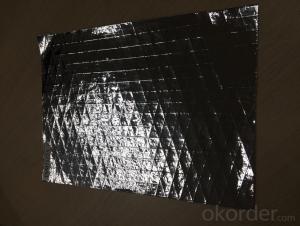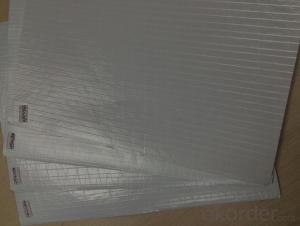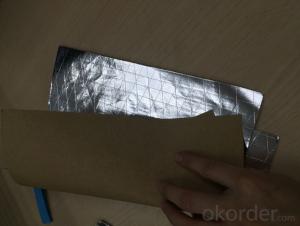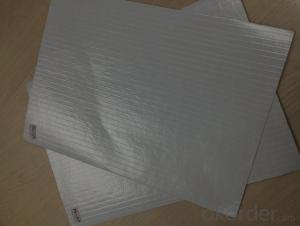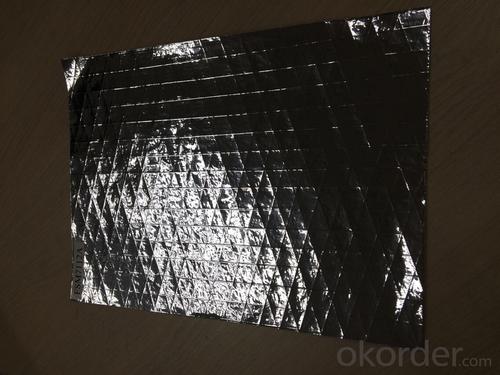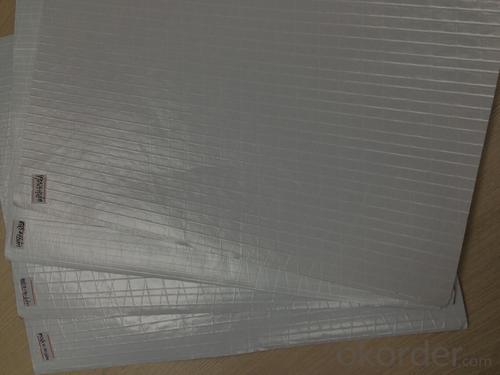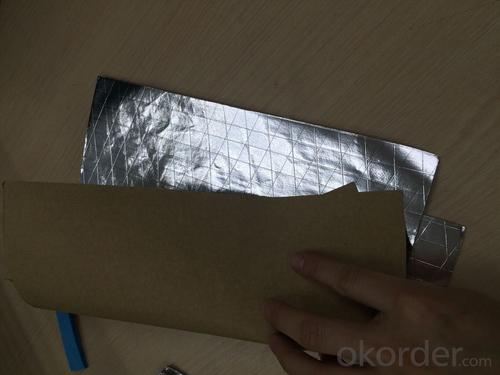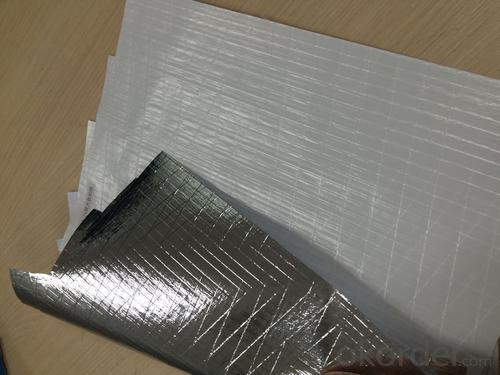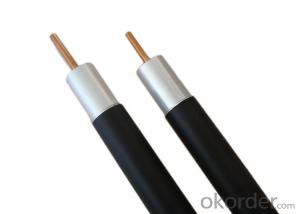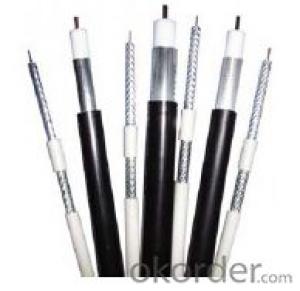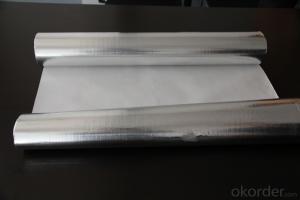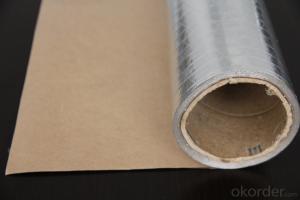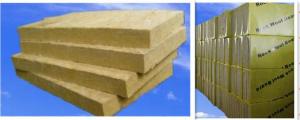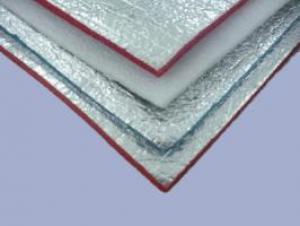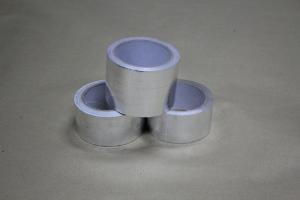Reflective Aluminum Foil Insulation Roofing Heat Insulation Aluminium Facing
- Loading Port:
- China main port
- Payment Terms:
- TT or LC
- Min Order Qty:
- 200 m²
- Supply Capability:
- 1000000 m²/month
OKorder Service Pledge
OKorder Financial Service
You Might Also Like
1.Structure of Aluminium Foil Facing Insulation Description:
Aluminium Foil Facing Insulation provides excellent insulation: reflects up to 97% of radiant energy in addition to resisting other types of heat transfer from conduction,convection,and radiation.The side of metalized PET/Alu forms an effective barrier against moisture,air currents and vapors.It is economical solution in many field. It is a light duty, Eco grade D/S foil Insulation. It is ideally used as sarking and insulation under roofs , in walls behind cladding or under timber floors , for residential and commercial building. Combining with glasswool or foam insulation, it is excellent as a vapor barrier for air-conditioning ducts, pipes and vessels.
2.Main Features of the Aluminium Foil Facing Insulation:
High heat reflection & low thermal conductivity
Heat preservation & energy saving
Moisture barrier & waterproof
Low flammability
Strong, durable & corrosion resistance
Light weight & easy to install
Clean, safe and fibre free & no odour and toxicity, totally environmental-friendly
No mildew growth & no rodent and insect nesting
3. Aluminium Foil Facing Insulation Images
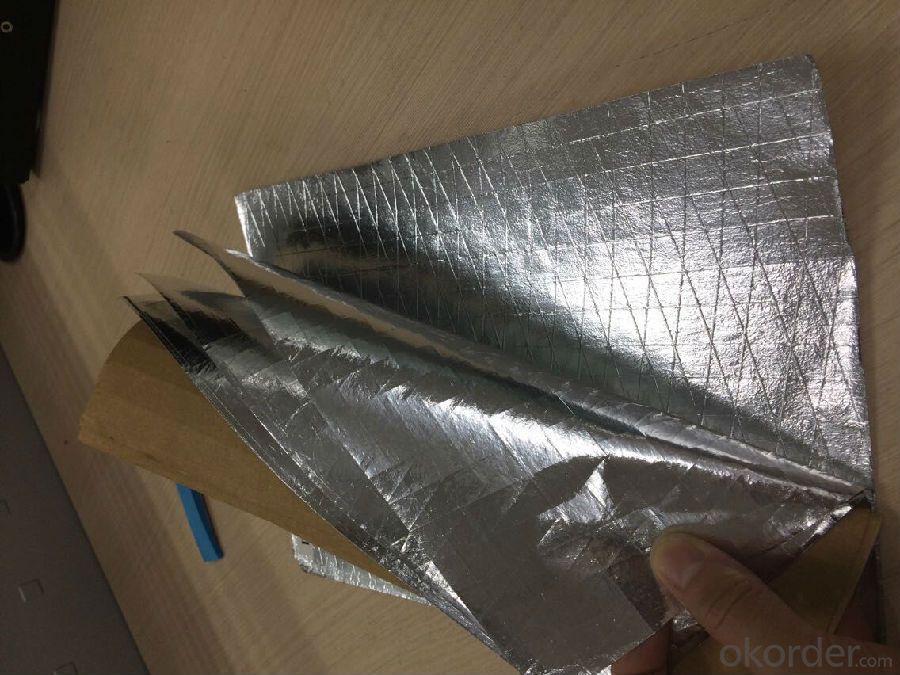
4. Aluminium Foil Facing Insulation Specification
a) Foil: 7μm
b) 2-way scrim: 12.5 x 12.5mm space
c) Polyethylene
d) Kraft: 50gsm, natural
2) FSK716B:
a) Foil: 7μm
b) 2-way scrim: 12.5 x 12.5mm space
c) Polyethylene
d) Kraft: 60gsm, natural
3) Roll width: 1.0, 1.2, 1.25, 1.30m
4) Roll length: 60, 120, 300, 500, 1600, 2750m
Physucal Properties | Test Method | Values (English) | Values(Metric) |
Basis Weight | Scale | 25.5lbs/1000 ft2 | 125g/m2 |
Tensile Strength | GB/T12914-1991 | 22.5lbs/inch(MD) | 3.79 kn/m(MD) |
13.9lbs/inch(XD) | 2.31 kn/m(XD) | ||
Bursting Strength | GB/T454-2002 | 36 lbs/psi | 248 kpa |
Water-resitant | 23 °C 24h | No phenomenon of layered | No phenomenon of layered |
Low-temperature resistant | -40 °C 1h | No phenomenon of layered | No phenomenon of layered |
High temperature resistant | 116 °C 4h | No leakage phenomenon | No leakage phenomenon |
Thickness | Micrometer | 0.0058 inch | 150 micron |
5.FAQ
We have organized several common questions for our clients,may help you sincerely:
①How about your company?
A world class manufacturer & supplier of castings forging in carbon steel and alloy steel,is one of the large-scale professional investment casting production bases in China,consisting of both casting foundry forging and machining factory. Annually more than 8000 tons Precision casting and forging parts are exported to markets in Europe
,America and Japan. OEM casting and forging service available according to customer’s requirements.
②How to guarantee the quality of the products?
We have established the international advanced quality management system,every link from raw material to final product we have strict quality test;We resolutely put an end to unqualified products flowing into the market. At the same time, we will provide necessary follow-up service assurance.
③How long can we receive the product after purchase?
The purchase of product within three working days, We will arrange the factory delivery as soon as possible. The pecific time of receiving is related to the state and position of customers.Commonly 7 to 10 working days can be served.
- Q: What distinguishes various grades of aluminum foil sheets from one another?
- <p>Different grades of aluminum foil sheets are distinguished by their thickness, strength, and purity. Grade 1 is the purest and softest, used for food wrapping and baking. Grade 2 is harder and more tear-resistant, suitable for heavy-duty use like grilling. Grade 3 is an alloy and offers high strength and durability, often used in industrial applications. Grade 4 is a heat-treatable alloy, providing high strength and used in aerospace and automotive industries. Each grade has specific applications based on its unique properties.</p>
- Q: What are the methods to ensure food does not adhere to aluminum foil while baking?
- <p>To prevent food from sticking to aluminum foil when baking, you can use a few methods. First, lightly grease the foil with cooking spray or oil before placing food on it. Second, consider using a non-stick spray or a light brushing of butter or oil directly on the food itself. Another option is to use parchment paper as a barrier between the food and the foil. Additionally, ensure the food is not overcooked, as this can cause it to stick. Lastly, avoid using shiny, new aluminum foil for acidic or sugary foods as it may react with the foil.</p>
- Q: The user is asking if it's possible to use aluminum foil with a reflective side to cook a pot roast.
- <p>Yes, you can use aluminum foil with a reflective side to make a pot roast. Aluminum foil is a versatile tool in cooking and can be used to wrap the roast, helping to retain moisture and cook the meat evenly. Ensure the foil is heavy-duty to withstand the cooking process and avoid punctures. Remember to monitor the roast closely to prevent overcooking, and adjust cooking times and temperatures as needed.</p>
- Q: Is it possible to recycle aluminum foil facing more than once?
- <p>Aluminum foil facing can be recycled, but it is typically not recycled multiple times due to the thinness and contamination issues. Recycling aluminum involves melting it down, and the thin foil can easily contaminate other aluminum products. Additionally, the foil facing is often laminated with other materials, making it difficult to separate and recycle. While some recycling facilities may accept it, the process is not as efficient as recycling other types of aluminum, and it's often advised to check with local recycling programs for their specific guidelines.</p>
- Q: Is it safe to use aluminum foil as a cooking surface? If yes, what kinds of foods are suitable for cooking with aluminum foil?
- <p>Yes, aluminum foil can be used for cooking, but it's important to use it safely. It's suitable for wrapping foods like fish, meats, and vegetables to retain moisture and flavor. It's also used for making packets for steaming or baking, and for lining baking sheets to prevent sticking. However, avoid using it with acidic foods or at high temperatures as it can react with the food or release aluminum into the food. Always use heavy-duty aluminum foil for cooking to ensure it can withstand the heat.</p>
- Q: Is it safe to use aluminum foil with a nonstick coating for cooking or baking purposes?
- <p>Using nonstick-coated aluminum foil for cooking or baking is generally safe, but it's important to follow the manufacturer's guidelines regarding temperature limits. Nonstick coatings are designed to withstand high temperatures, but excessive heat can cause them to break down or release harmful fumes. Always ensure the foil is placed in a way that the nonstick side does not come into direct contact with the heat source to prevent damage to the coating. Additionally, avoid using sharp or abrasive objects on the nonstick surface to maintain its integrity.</p>
- Q: What are the primary applications or purposes of aluminum foil facing in various industries or everyday life?
- <p>Aluminum foil facing is primarily used for its heat reflective properties, making it ideal for insulation in construction and roofing. It also serves as a moisture barrier and vapor barrier in walls and ceilings, helping to prevent mold and mildew. In the HVAC industry, it's used for duct insulation, enhancing energy efficiency. Additionally, it's utilized in packaging for food and pharmaceuticals to protect contents from light, air, and moisture, thus preserving freshness and quality.</p>
- Q: This question asks for methods to clean stubborn food residue from the aluminum foil facing of a baking sheet or similar kitchen item.
- <p>To remove stuck-on food from aluminum foil facing, first let the surface cool down. Then, use a plastic scraper or an old credit card to gently lift the residue without scratching the foil. For stubborn stains, make a paste of baking soda and water, apply it to the area, and let it sit for a few minutes before scrubbing. Alternatively, use a mixture of vinegar and water to loosen the food particles. After cleaning, rinse thoroughly and dry to prevent further food adhesion.</p>
- Q: Is it safe to use old aluminum foil for food packaging, considering potential health risks and material degradation?
- <p>Using old aluminum foil for food packaging is not recommended. Over time, aluminum foil can become discolored, thin, or develop pinholes, which can compromise its integrity. These changes can lead to food contamination and the foil's ability to protect food from bacteria or other contaminants. Additionally, old aluminum foil may contain residues from previous uses that could mix with new food items, potentially causing off-flavors or health concerns. It's best to use fresh, clean aluminum foil for food packaging to ensure safety and hygiene.</p>
- Q: This question asks for instructions on how to store food wrap materials after they have been used.
- <p>After using food wrap materials, it's important to clean them properly before storing. Rinse off any food residue with warm water and mild dish soap. Avoid using abrasive materials that could damage the wrap. Once clean, gently pat dry with a clean towel or let air dry. Store the wraps in a cool, dry place away from direct sunlight to prevent degradation. You can use a clean, airtight container or resealable plastic bag to keep them protected and dust-free. Always check for any signs of wear or damage before reusing to ensure food safety.</p>
Send your message to us
Reflective Aluminum Foil Insulation Roofing Heat Insulation Aluminium Facing
- Loading Port:
- China main port
- Payment Terms:
- TT or LC
- Min Order Qty:
- 200 m²
- Supply Capability:
- 1000000 m²/month
OKorder Service Pledge
OKorder Financial Service
Similar products
Hot products
Hot Searches
Related keywords
